否定句、一般疑问句.
一般疑问句,否定句,肯定、否定回答,选择疑问句(新概念)
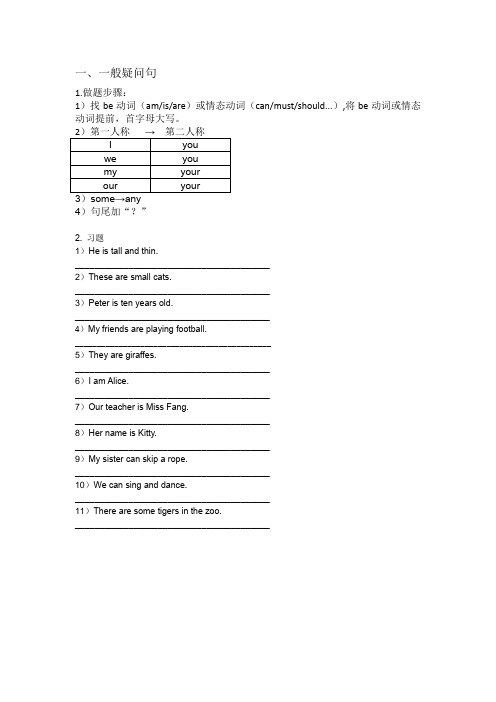
一、一般疑问句1.做题步骤:1)找be动词(am/is/are)或情态动词(can/must/should...),将be动词或情态动词提前,首字母大写。
4)句尾加“?”2. 习题1)He is tall and thin.________________________________________2)These are small cats.________________________________________3)Peter is ten years old.________________________________________4)My friends are playing football._____________________________________________5)They are giraffes.________________________________________6)I am Alice.________________________________________7)Our teacher is Miss Fang.________________________________________8)Her name is Kitty.________________________________________9)My sister can skip a rope.________________________________________10)We can sing and dance.________________________________________11)There are some tigers in the zoo.________________________________________二、一般疑问句的肯定回答/否定回答1. 主语一致1) Is he Tom?2) Are they good friends?3) Is it a panda?___________________ _____________________ ______________________ ___________________ _____________________ ______________________4) Is your sister a pupil? 5) Are Danny and Kitty friends? 6)Is the desk clean?___________________ _____________________ ______________________ ___________________ _____________________ ______________________注意①:问句用you,回答改用I或We1) Are you Jack?2) Are you Chinese?3) Are you policemen?___________________ _____________________ ______________________ ___________________ _____________________ ______________________注意②:问句用指示代词this/that或these/those,回答改用it或they(不管是人还是物) 1) Is this your T-shirt?2) Are those your coats? 3) Is that a dress?___________________ _____________________ ______________________ ___________________ _____________________ ______________________4) Is that your son? 5) Are these your toys? 6) Is this your daughter?___________________ _____________________ ______________________ ___________________ _____________________ ______________________注意 :若问句中this/that或these/those为限定词,则主语一致1) Is that man your father? 2) Are these peaches pink? 3) Is this girl your daughter? ___________________ _____________________ ______________________ ___________________ _____________________ ______________________三、否定句1.做题步骤1)在be动词后加not。
否定句及一般疑问句
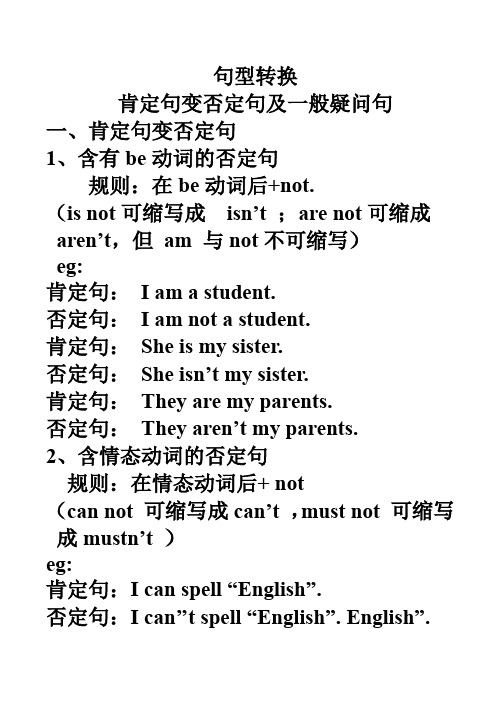
句型转换肯定句变否定句及一般疑问句一、肯定句变否定句1、含有be动词的否定句规则:在be动词后+not.(is not可缩写成isn’t ;are not可缩成aren’t,但am 与not不可缩写)eg:肯定句:I am a student.否定句:I am not a student.肯定句:She is my sister.否定句:She isn’t my sister.肯定句:They are my parents.否定句:They aren’t my parents.2、含情态动词的否定句规则:在情态动词后+ not(can not 可缩写成can’t ,must not 可缩写成mustn’t )eg:肯定句:I can spell “English”.否定句:I can’’t spell “English”.English”.肯定句:I must find it.否定句:I mustn’t find it.3、含有实义动词的句子的否定句构成(1)第三人称单数做主语。
(he、she、it或表示单个人或物的第三人称名词)规则:要在行为动词前加上助动词doesn’t,然后将动词恢复原形。
eg :肯定句:He has a soccer ball.否定句:He doesn’t have a soccer ball.(2)其它人称做主语规则:在行为动词前加don’t ,句子中的行为动词用原形。
eg:肯定句:They like bananas.否定句:They don’t like bananas.注:(1)在变否定句时,如遇some应变any Here are some books.Here aren’t any books.二、肯定句变一般疑问句1、含有be动词的句子变一般疑问句规则:把be动词提至句首,第一人称变第二人称,句末句号变问号。
(I/we变成youMy/our变成your)肯定句:I am a student.一般疑问句:Are you a student?肯定句:She is my sister.一般疑问句:Is she your sister?肯定句:They are my parents.一般疑问句:Are they your parents?2、含有情态动词的句子变一般疑问句规则:把情态动词提至句首,第一人称变第二人称,句末句号变问号。
一般疑问句和否定句以及全面的配套练习

一般疑问句和否定句以及全面的配套练习一、一般疑问句1. 概念:一般指用Yes 或No 回答的疑问句;2. 特点:一般翻译为“…吗?”,故回答用“是”或“不是”;3. 分类:①含有be 动词的陈述句变为一般疑问句;②含有实意动词的陈述句变为一般疑问句;③含有情态动词的陈述句变为一般疑问句;※4.具体分类学习:①含有be 动词的陈述句变为一般疑问句学习要点1:将be 动词提前;若主语是第一人称,要变为第二人称;其他句子成分位子不变;(your your)学习要点2:回答时的结构如下:Yes,人称代词 + be 动词. No,人称代词 + be not 缩写.其中,回答的人称代词和be 动词要和问句内容相一致;学习要点3:be 动词回答时用到的否定缩写积累:首先:am not 没有缩写, 否定回答缩写为:No, I’m not.其次:is not = isn’t are not = aren’t知识回顾:Be 动词用法口诀:”我”用am, “你”用are, is 连着“他、她、他、它”;单数用“is”,复数用“are”;例句分析:a.Is she a doctor?Yes, she is. / No, she isn’t.b.Are these his dictionaries?Yes, they are. / No, they aren’t.c.随堂练习1: This is her watch. ?. /.总结:当陈述句句子主语是this/that,回答用it 来指代之;当陈述句句子主语是these/those,回答用they 来指代之;随堂练习2:?. /.d.Is she your cousin?Yes, she is. / No, she isn’t.延伸学习:Be 动词的肯定陈述句变为否定陈述句要点:变为否定句,直接在be 动词后面加not;例句分析:Those are not their books.b.He is not my good friend.c.I am not a student.随堂练习:This is my ruler.否定句:.一般疑问句:? Yes,. / No,.小试牛刀:1.She is always a good student.(改为一般疑问句,作否定回答)一般疑问句:?Yes,. / No,.2.Daniel and Tommy(be) in Class One.3.There(be) some water in the bottle.4.I(be) ill. I’m staying in bed.5.What day(be) it today? It’s Saturday.②含有实意动词的陈述句变为一般疑问句;学习要点1:找助动词do / does 构成疑问和否定;学习要点2: 一般疑问句也要找do/does,放句首构成疑问;例句分析1:I have an apple. : 我有一个苹果。
肯定句、否定句、 肯定句、否定句、一般疑问句和特殊疑问句的详解
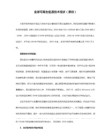
怎样变一般疑问句、否定句和特殊疑问句
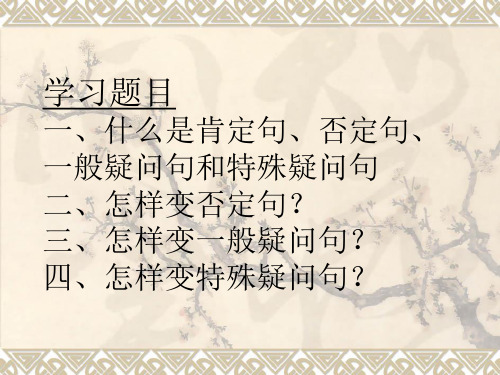
二、怎样变否定句
有am,
is, are的句子, 肯定句变否定句:在am, is, are后面加上not,其 余按顺序照抄。 例如:I am a boy. I am not a boy. He is a teacher. He is not a teacher. They are friends. They are not friends. 他们是朋友。 他们不是朋友。
学习题目
一、什么是肯定句、否定句、 一般疑问句和特殊疑问句 二、怎样变否定句? 三、怎样变一般疑问句? 四、怎样变特殊疑问句?
一、be动词:am,
is, are 二、肯定句、否定句、一般疑问句和特殊 疑问句定义 1.肯定句:表示肯定的意思, 即不含有否 定词“不”。 比如:我是一个学生 I am a student. 他是一个老师。He is a teacher. 2.否定句:表示否定的意思。 比如:我不是一个男孩。 I am not a boy 他不是一个老师。 He is not a teacher.
一般疑问句:回答为“是yes”或者“否no” 的问句。 比如:你是一个学生吗? Are you a student? Yes, I am./No, I am not. 4. 特殊疑问句:回答不是“是yes”或者“否 no”的问句,而是根据提问内容具体回答。 比如:这是什么? What’s this? It is a map.
四、怎样变特殊疑问句?
就划线部分提问(变特殊疑问句)
This
is a book. 第一步:变一般疑问句 Is this a book? 第二步:找合适的特殊疑问词 Is this what ? 第三步:特殊疑问词提前放到句首,并大写, 其余按顺序照抄,省略划线部分。得出正确 答案:What is this?
小学英语四种基本句型-肯定句、否定句、一般疑问句与特殊疑问句
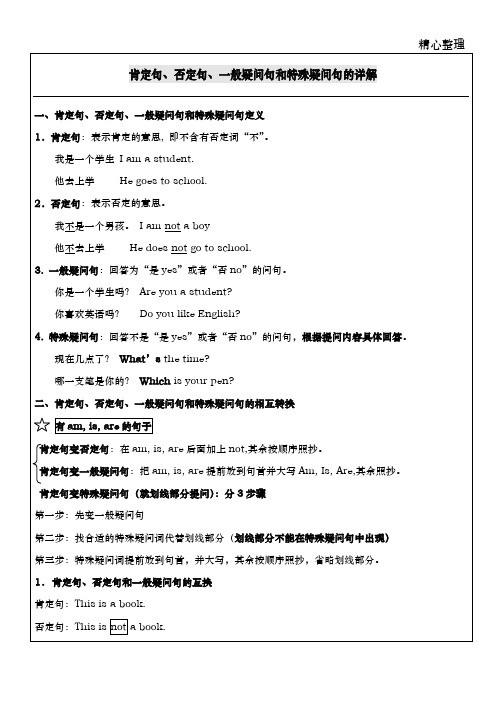
精心整理
一般疑问句:Is this a book? 肯定回答:Yes, it is. 否定回答:No, it isn’t. 2. 就划线部分提问(变特殊疑问句) This is a book. 第一步:变一般疑问句 Is this a book? 第二步:找合适的特殊疑问词 Is this what ? 第三步:特殊疑问词提前放到句首,并大写,其余按顺序照抄,省略划线部分。What is this?
肯定句、否定句、一般疑问句和特殊疑问句的详解
精心整理
一、肯定句、否定句、一般疑问句和特殊疑问句定义 1.肯定句:表示肯定的意思, 即不含有否定词“不”。
我是一个学生 I am a student. 他去上学 He goes to school. 2.否定句:表示否定的意思。 我不是一个男孩。 I am not a boy 他不去上学 He does not go to school. 3. 一般疑问句:回答为“是 yes”或者“否 no”的问句。 你是一个学生吗? Are you a student? 你喜欢英语吗? Do you like English? 4. 特殊疑问句:回答不是“是 yes”或者“否 no”的问句,根据提问内容具体回答。 现在几点了? What’s the time? 哪一支笔是你的? Which is your pen? 二、肯定句、否定句、一般疑问句和特殊疑问句的相互转换 有 am, is, are 的句子 肯定句变否定句:在 am, is, are 后面加上 not,其余按顺序照抄。 肯定句变一般疑问句:把 am, is, are 提前放到句首并大写 Am, Is, Are,其余照抄。 肯定句变特殊疑问句(就划线部分提问):分 3 步骤 第一步:先变一般疑问句 第二步:找合适的特殊疑问词代替划线部分(划线部分不能在特殊疑问句中出现) 第三步:特殊疑问词提前放到句首,并大写,其余按顺序照抄,省略划线部分。 1. 肯定句、否定句和一般疑问句的互换 肯定句:This is a book. 否定句:This is not a book.
一般现在时的构成、否定句、一般疑问句的构成
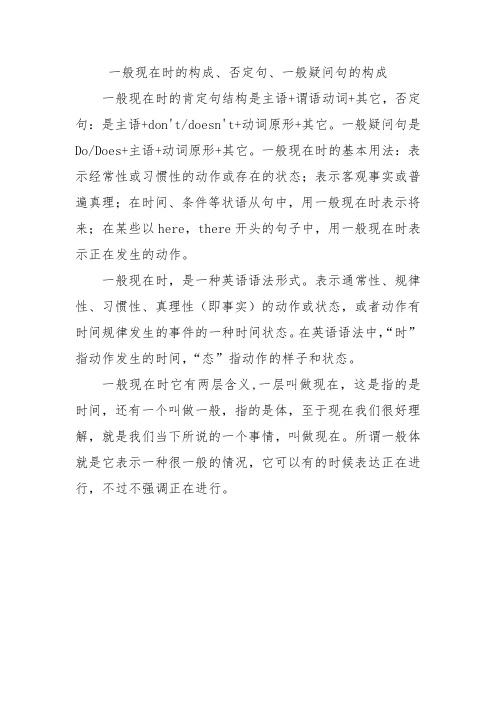
一般现在时的构成、否定句、一般疑问句的构成
一般现在时的肯定句结构是主语+谓语动词+其它,否定句:是主语+don't/doesn't+动词原形+其它。
一般疑问句是Do/Does+主语+动词原形+其它。
一般现在时的基本用法:表示经常性或习惯性的动作或存在的状态;表示客观事实或普遍真理;在时间、条件等状语从句中,用一般现在时表示将来;在某些以here,there开头的句子中,用一般现在时表示正在发生的动作。
一般现在时,是一种英语语法形式。
表示通常性、规律性、习惯性、真理性(即事实)的动作或状态,或者动作有时间规律发生的事件的一种时间状态。
在英语语法中,“时”指动作发生的时间,“态”指动作的样子和状态。
一般现在时它有两层含义,一层叫做现在,这是指的是时间,还有一个叫做一般,指的是体,至于现在我们很好理解,就是我们当下所说的一个事情,叫做现在。
所谓一般体就是它表示一种很一般的情况,它可以有的时候表达正在进行,不过不强调正在进行。
一般将来时肯定句,否定句,一般疑问句及其回答的句式

一般将来时肯定句,否定句,一般疑问句及其回答的句式
一般将来时(Simple Future Tense):
●肯定句句式:主语+ will + 动词原形+ 其他。
I will travel to Paris next month.(我下个月将要去巴黎。
)
●否定句句式:主语+ will not (won't) + 动词原形+ 其他。
She won't attend the meeting tomorrow.(她明天不会参加会议。
)
●一般疑问句句式:Will + 主语+ 动词原形+ 其他?
Will you join us for dinner?(你会和我们一起吃晚饭吗?)
●回答:
1.肯定回答:Yes, 主语+ will.
Yes, I will.
2.否定回答:No, 主语+ will not (won't).
No, I won't.
这些句式用于表达将来发生的动作或事件,其中"will" 是助动词,后接动词的原形。
在否定句中,可以使用缩写形式"won't"。
在疑问句中,将"will" 提到主语前。
回答时,可以简单回答肯定或否定。
一般过去时的肯定句,否定句,一般疑问句,特殊疑问句
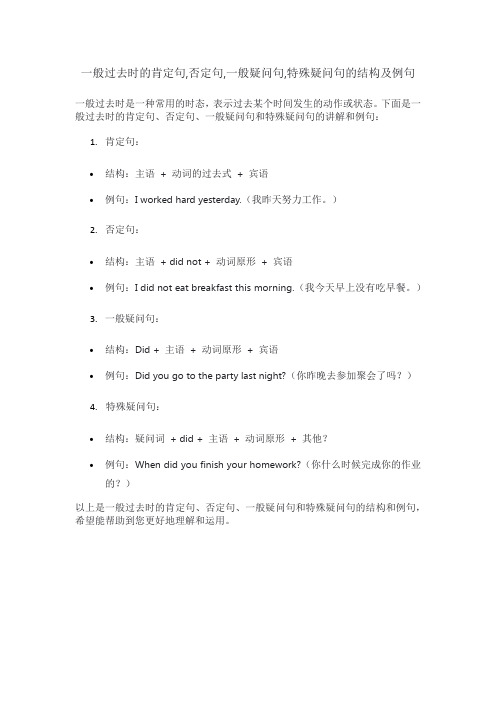
一般过去时的肯定句,否定句,一般疑问句,特殊疑问句的结构及例句
一般过去时是一种常用的时态,表示过去某个时间发生的动作或状态。
下面是一般过去时的肯定句、否定句、一般疑问句和特殊疑问句的讲解和例句:
1.肯定句:
•结构:主语+ 动词的过去式+ 宾语
•例句:I worked hard yesterday.(我昨天努力工作。
)
2.否定句:
•结构:主语+ did not + 动词原形+ 宾语
•例句:I did not eat breakfast this morning.(我今天早上没有吃早餐。
)
3.一般疑问句:
•结构:Did + 主语+ 动词原形+ 宾语
•例句:Did you go to the party last night?(你昨晚去参加聚会了吗?)
4.特殊疑问句:
•结构:疑问词+ did + 主语+ 动词原形+ 其他?
•例句:When did you finish your homework?(你什么时候完成你的作业的?)
以上是一般过去时的肯定句、否定句、一般疑问句和特殊疑问句的结构和例句,希望能帮助到您更好地理解和运用。
英语肯定句否定句一般疑问句和特殊疑问句
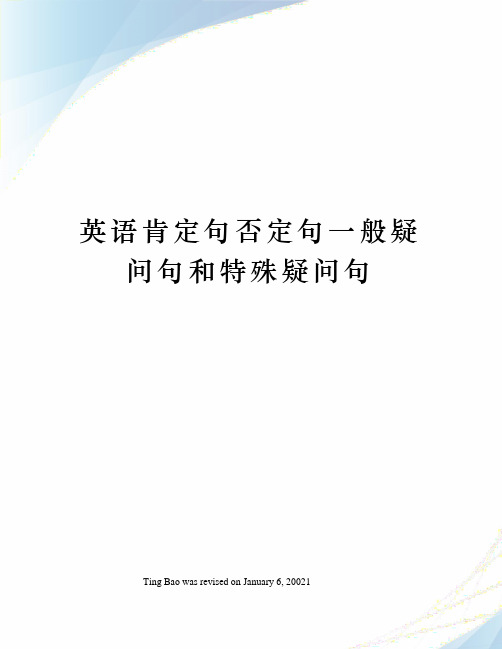
英语肯定句否定句一般疑问句和特殊疑问句Ting Bao was revised on January 6, 20021小学英语肯定句、否定句、一般疑问句和特殊疑问句一、be动词:am, is, are二、肯定句、否定句、一般疑问句和特殊疑问句定义1.肯定句:表示肯定的意思,即不含有否定词“不”。
比如:我是一个学生?I am a student.他去上学?He goes to school.2.否定句:表示否定的意思。
比如:我不是一个男孩。
I amnota boy他不去上学He doesnotgo to school.3.一般疑问句:回答为“是yes”或者“否no”的问句。
比如:你是一个学生吗Are you a student你喜欢英语吗Do you like English4.特殊疑问句:回答不是“是yes”或者“否no”的问句,根据提问内容具体回答。
比如:现在几点了?What’s the time?哪一支笔是你的Which is your pen三、肯定句、否定句、一般疑问句和特殊疑问句的相互转换有am, is, are的句子,肯定句变否定句:在am, is, are后面加上not,其余按顺序照抄。
肯定句变一般疑问句:把am, is, are提前放到句首并大写Am, Is, Are,其余照抄。
肯定句变特殊疑问句(就划线部分提问):分3步骤第一步:先变一般疑问句第二步:找合适的特殊疑问词代替划线部分第三步:特殊疑问词提前放到句首,并大写,其余按顺序照抄,省略划线部分。
注意:1.一定先变一般疑问句。
但是,如果问的是主语或主语的定语时,语序不变,为"特殊疑问词(+主语)+陈述句"。
如:Li ming's not here today. Who's not here today今天谁没来2.1.肯定句、否定句和一般疑问句的互换肯定句:This is a book.否定句:This isnota book.一般疑问句:Is this a book?肯定回答:Yes, it is.否定回答:No, it isn’t.2.就划线部分提问(变特殊疑问句)This is?a book.第一步:变一般疑问句Is thisa book第二步:找合适的特殊疑问词Is thiswhat第三步:特殊疑问词提前放到句首,并大写,其余按顺序照抄,省略划线部分。
一般疑问句和否定句讲解和练习题
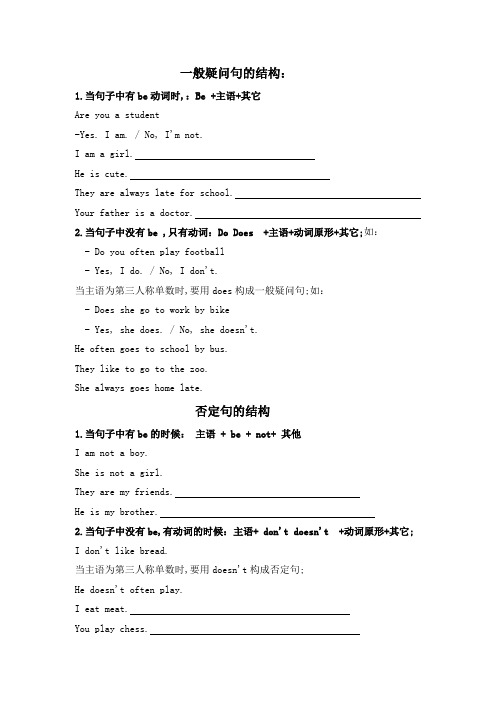
一般疑问句的结构:1.当句子中有be动词时,:Be +主语+其它Are you a student-Yes. I am. / No, I'm not.I am a girl.He is cute.They are always late for school. Your father is a doctor.2.当句子中没有be ,只有动词:Do Does +主语+动词原形+其它;如:- Do you often play football- Yes, I do. / No, I don't.当主语为第三人称单数时,要用does构成一般疑问句;如:- Does she go to work by bike- Yes, she does. / No, she doesn't.He often goes to school by bus.They like to go to the zoo.She always goes home late.否定句的结构1.当句子中有be的时候:主语 + be + not+ 其他I am not a boy.She is not a girl.They are my friends.He is my brother.2.当句子中没有be,有动词的时候:主语+ don't doesn't +动词原形+其它;I don't like bread.当主语为第三人称单数时,要用doesn't构成否定句;He doesn't often play.I eat meat.You play chess.She always does the housework on Sunday.The dog plays with its tail all the day.一、用所给动词的一般现在时填空;1. We often play in the playgrounnd.2 you brush your teeth every morning3. What do he usually do after school4. Danny study English, Chinese, Maths, Science, and Art an school.5. Mike sometimes go to the park with his sister.6. At eight at night, she watch TV with his family.7. Mike read English every day8. How many lessons your classmate have on Monday9. What time his mother do the housework二、按要求改写句子;1Do you often play football after school 改为肯定句2I have some books. 改为否定句3Gao Shan’s sister likes playing table tennis. 改为否定句4She lives in a small town near New York. 改为一般疑问句5I watch TV every day. 改为一般疑问句6We have four lessons. 改为否定句7Nancy doesn’t run fast. 改为肯定句三、单项选择;1. you have a bookA. DoB. AreC. IsD. Have2. They on a farm.A. workingB. is workC. workD. is worked3. Does Peter like to watch TV .A. Yes, he likeB. No, he doesn’tC. Yes, he’d likeD. No, he likes4. She doesn’t her homework in the afternoon.A. doingB. to doC. doesD. do5. Where’s my camera I it.A.am not findingB. am not seeingC. can’t findD. can’t lookat6. you usually late for school No, .A. Do, I amB. Does, notC. Are, I’m notD. Are, I aren’t7. she home at six every dayA. Is, leaveB. Does, leaveC. Is, leavesD. Does, left8. Mr. Yang English this term.A. teaches ourB. teaches usC. teachs usD. teach ourI have 3 new teachers. They are my English teacher, my teacher and my Chinese teacher. Miss zhao is pretty and active. She's a universitystudent. She's our English teacher. My teacher is Mr. Chen. He's tall and strong, and he's strict, too. Miss Sun is my Chinese teacher. She's quiet. She has long hair and big eyes.1. I have new teachers. A. twoB. threeC. four2. Miss Zhao is myteacher. A. EnglishB. ChineseC. PE3. Mr. Chen is . A. tall B. strong C. tall and strong4. Is my teacher strictA. Yes, she is B. Yes, he is C. No, he isn't5. Miss Sun is . A. quiet B. active C. strict。
否定句_一般疑问句和特殊疑问句讲解
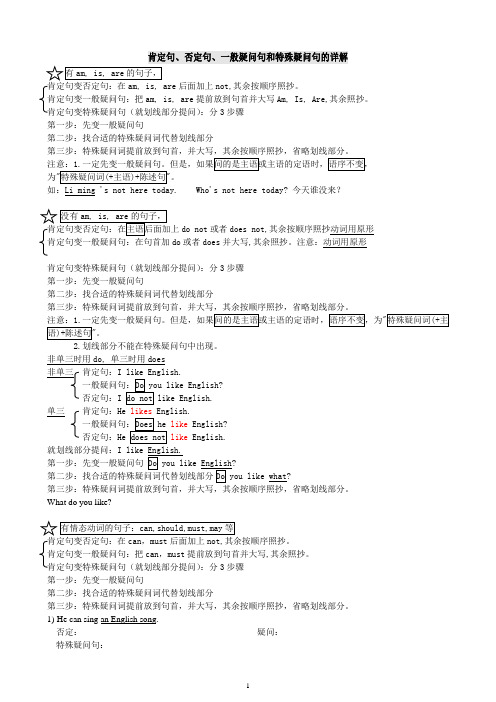
肯定句、否定句、一般疑问句和特殊疑问句的详解有 am, is, are 的句子, 肯定句变否定句:在 am, is, are 后面加上 not,其余按顺序照抄。
肯定句变一般疑问句:把 am, is, are 提前放到句首并大写 Am, Is, Are,其余照抄。
肯定句变特殊疑问句(就划线部分提问) :分 3 步骤 第一步:先变一般疑问句 第二步:找合适的特殊疑问词代替划线部分 第三步:特殊疑问词提前放到句首,并大写,其余按顺序照抄,省略划线部分。
注意:1.一定先变一般疑问句。
但是,如果问的是主语或主语的定语时,语序不变, 为" 特殊疑问词(+主语)+陈述句 "。
如:Li ming 's not here today. Who's not here today? 今天谁没来? 没有 am, is, are 的句子, 肯定句变否定句:在主语后面加上 do not 或者 does not,其余按顺序照抄动词用原形 肯定句变一般疑问句:在句首加 do 或者 does 并大写,其余照抄。
注意:动词用原形 肯定句变特殊疑问句(就划线部分提问) :分 3 步骤 第一步:先变一般疑问句 第二步:找合适的特殊疑问词代替划线部分 第三步:特殊疑问词提前放到句首,并大写,其余按顺序照抄,省略划线部分。
注意:1.一定先变一般疑问句。
但是,如果问的是主语或主语的定语时,语序不变,为" 特殊疑问词(+主 语)+陈述句 "。
2.划线部分不能在特殊疑问句中出现。
非单三时用 do, 单三时用 does 非单三 肯定句:I like English. 一般疑问句: Do you like English? 否定句:I do not like English. 单三 肯定句:He likes English. 一般疑问句: Does he like English? 否定句:He does not like English. 就划线部分提问:I like English. 第一步:先变一般疑问句 Do you like English? 第二步:找合适的特殊疑问词代替划线部分 Do you like what? 第三步:特殊疑问词提前放到句首,并大写,其余按顺序照抄,省略划线部分。
小学英语四种基本句型-肯定句、否定句、一般疑问句及特殊疑问句
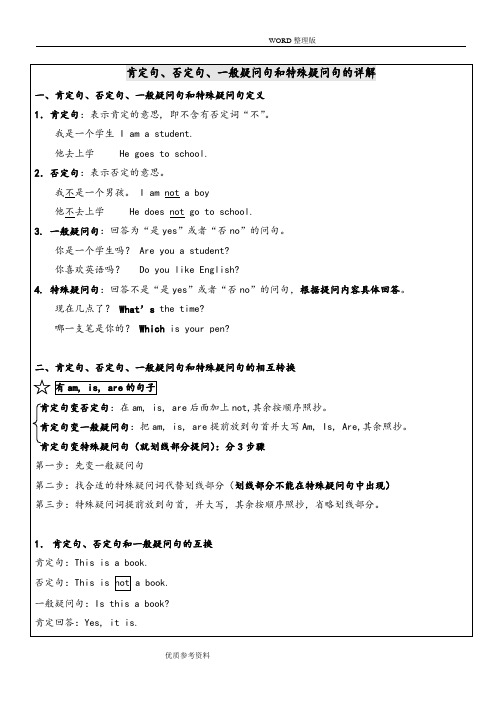
WORD 整理版
常用特殊疑问词及词组:
when 什么时间(问时间)
what date 什么日期 问具体日期
who 谁(问人)
what place 什么地点问具体地址
whose 谁的 问主人
how …怎么样 问情况
where 在哪里 问地点
how old 多大 问年龄
which 哪一个 问选择
how many 多少 问数量
I have been there already.→I haven't been there yet.
熟记变特殊疑问句时,容易判断错的情况。 1、 数词
表示年龄:He is fifty-five. How old is he ? 表示时间:It’s fifty-five. What’s the time? 表示加法:Six and two is eight. What’s six and two? 表示价格:The shirt is thirty yuan . How much is the shirt? 表示多少:I have three brothers. How many brothers do you have? 2、 姓名和人 表示人名:My name is Gina. What’s your name? 表示人:The woman is Gina. Who is the woman ? 3、 长度和距离 表示距离:It’s five hundred metres away from here. How far is it from here? 表示长度:It’s five hundred metres. How long is it ?
B: _______ ?
A: I want to make a kite.
否定句和一般疑问句的变化规则
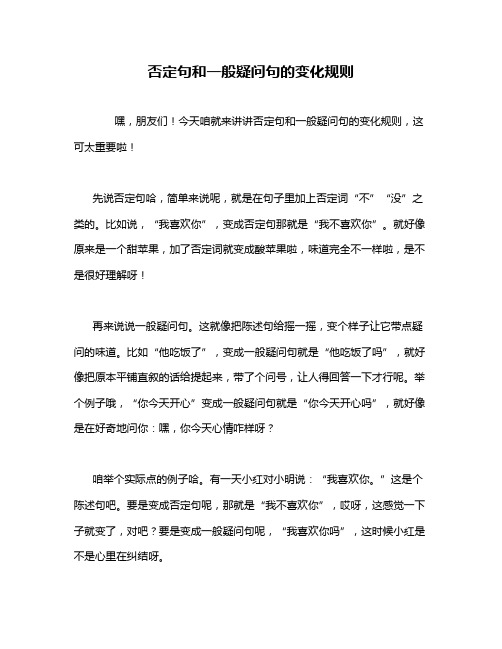
否定句和一般疑问句的变化规则
嘿,朋友们!今天咱就来讲讲否定句和一般疑问句的变化规则,这可太重要啦!
先说否定句哈,简单来说呢,就是在句子里加上否定词“不”“没”之类的。
比如说,“我喜欢你”,变成否定句那就是“我不喜欢你”。
就好像原来是一个甜苹果,加了否定词就变成酸苹果啦,味道完全不一样啦,是不是很好理解呀!
再来说说一般疑问句。
这就像把陈述句给摇一摇,变个样子让它带点疑问的味道。
比如“他吃饭了”,变成一般疑问句就是“他吃饭了吗”,就好像把原本平铺直叙的话给提起来,带了个问号,让人得回答一下才行呢。
举个例子哦,“你今天开心”变成一般疑问句就是“你今天开心吗”,就好像是在好奇地问你:嘿,你今天心情咋样呀?
咱举个实际点的例子哈。
有一天小红对小明说:“我喜欢你。
”这是个陈述句吧。
要是变成否定句呢,那就是“我不喜欢你”,哎呀,这感觉一下子就变了,对吧?要是变成一般疑问句呢,“我喜欢你吗”,这时候小红是不是心里在纠结呀。
对于否定句和一般疑问句的变化规则,真的要掌握好呀,不然说话表达可能就不准确啦!不管是在日常交流,还是学习写作中,都超级有用的呀!总之,一定要好好学起来,这样才能让我们的语言更加丰富、准确!这就是我的看法,你们觉得呢?。
一般疑问句、否定句
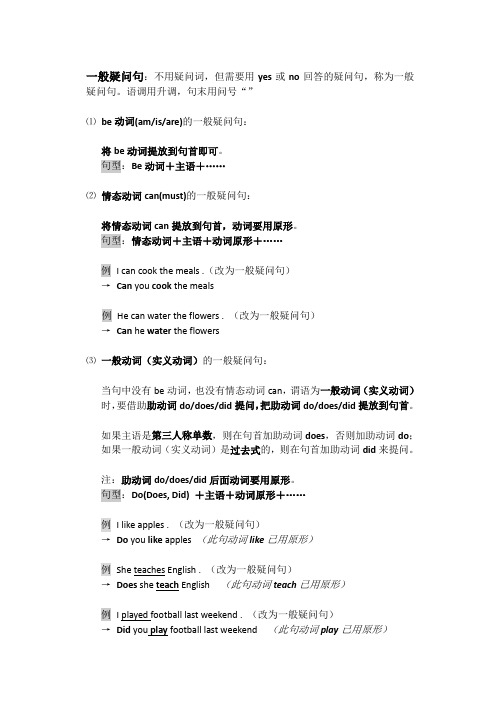
一般疑问句:不用疑问词,但需要用yes或no回答的疑问句,称为一般疑问句。
语调用升调,句末用问号“”⑴be动词(am/is/are)的一般疑问句:将be动词提放到句首即可。
句型:Be动词+主语+……⑵情态动词can(must)的一般疑问句:将情态动词can提放到句首,动词要用原形。
句型:情态动词+主语+动词原形+……例I can cook the meals .(改为一般疑问句)→Can you cook the meals例He can water the flowers . (改为一般疑问句)→Can he water the flowers⑶一般动词(实义动词)的一般疑问句:当句中没有be动词,也没有情态动词can,谓语为一般动词(实义动词)时,要借助助动词do/does/did提问,把助动词do/does/did提放到句首。
如果主语是第三人称单数,则在句首加助动词does,否则加助动词do;如果一般动词(实义动词)是过去式的,则在句首加助动词did来提问。
注:助动词do/does/did后面动词要用原形。
句型:Do(Does, Did) +主语+动词原形+……例I like apples . (改为一般疑问句)→Do you like apples (此句动词like已用原形)例She teaches English . (改为一般疑问句)→Does she teach English (此句动词teach已用原形)例I played football last weekend . (改为一般疑问句)→Did you play football last weekend (此句动词play已用原形)表示否定事实的句子叫做否定句。
be动词、情态动词can(must)、一般动词(实义动词)的否定句:⑴在be动词后面加not句型:主语+be动词+not+……例I am a teacher .(改为否定句)→I am not a teacher .例He is a boy . (改为否定句)→He is not a boy .例They are students . (改为否定句)→They are not students .⑵在情态动词can(must)后面加not句型:主语+情态动词+not+动词原形例I can make the bed . (改为否定句)→I can not make the bed .⑶如果句中没有be动词,也没有情态动词can,只有一般动词(实义动词),则在一般动词(实义动词)前加don’t(doesn’t, didn’t)构成。
初一否定句-一般疑问句和特殊疑问句讲解

肯定句、否定句、一般疑问句和特殊疑问句的详解1.:在am , isnot ,其余按顺序照抄。
例如:。
→ 。
(I am not=I’m not )。
→ (is not= isn't )。
→ 。
(are not= aren ’t )2. 肯定句变一般疑问句:把 am, is, are 提前放到句首并大写 Is , Are,其余照抄,句号变问号。
(Am 变为Are,I 变为you ,We 变为you, My/ Our 变为 your )肯定回答 / 否定回答 例如 → ? —Yes , I am./ No, I ’m not 。
→ Is he a boy? -Yes, he is 。
/ No , he isn ’t 。
cars. → Are they cars ? -Yes , they are 。
/ No,they aren't. We are students 。
→ Are you students? -Yes , we are 。
/ No , we aren ’ 。
→ ?he is 。
/ No , he isn't. 。
→(回答时,原句的某人,王老师,爸爸,简,康康等要用人称代词替换.)—Yes, she is./ No, she isn ’t.→ Is Jane a good student? —Yes , she is./ No, she isn ’t 。
→ Is the dog his ? –Yes, it is./ No , it isn ’t. 3.肯定句变特殊疑问句(就划线部分提问):分3步骤 第一步:先变一般疑问句 第二步:找合适的特殊疑问词代替划线部分 第三步:特殊疑问词提前放到句首,注意:1如: Li Ming 's not here 。
—1.Is Li Ming not here ? —2。
Is who not here ? —3。
